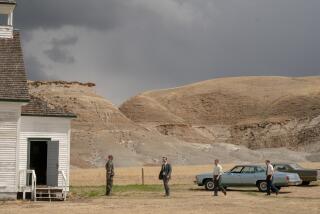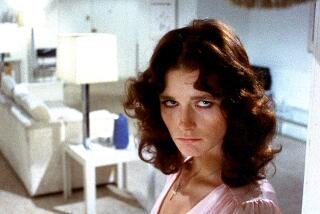Dial F for Five From Hitchcock
- Share via
By today’s standards it seems a marvel that Woody Allen turns out roughly a film a year. Yet for the 41 years from 1925 to 1966--longer even than Allen’s entire career--Alfred Hitchcock made 50 films, and nobody thought his average of more than one a year the slightest bit unusual.
The Hitchcock festival “Five From the Fifties” at the Port Theatre in Corona del Mar, beginning Friday, taps just a fraction of his huge output. But it still manages to show the great British director working at the peak of his prolific career.
Notwithstanding the absence of “Rear Window” (1954), which ranks among his best and most popular pictures, the festival offers a balanced selection from what is widely considered Hitchcock’s strongest decade in Hollywood: “Vertigo” (1958) (Friday-Saturday), “Strangers on a Train” (1951) and “Dial M for Murder” (1953) on a double bill, (Sunday-Monday) and “North by Northwest” (1959) and “To Catch a Thief” (1955) on a double bill (Tuesday-Dec.4).
Hitchcock was not the sort of director to enthuse over his own work, unless it was to talk about technical innovations. When Francois Truffaut asked him to evaluate “Dial M for Murder,” Hitchcock, who’d shot the picture speedily (in 36 days) to fulfill a contract, replied: “There isn’t very much to say about it.”
Truffaut disagreed, almost chiding Hitchcock for thinking of it as a minor film. “It’s one of the pictures I’ve seen over and over,” he said, “and I enjoy it more each time.”
But what impressed Truffaut about it--the editing, mainly, and the rhythms, especially the intensity of the dialogue--is perhaps less important than the simple fact that “Dial M for Murder” was the first of three pictures that Hitchcock would make with Grace Kelly. (The other two were “Rear Window” and “To Catch a Thief.”)
Among all of Hitchcock’s leading ladies, only Ingrid Bergman made as many (“Spellbound,” “Notorious” and “Under Capricorn,” all in the 1940s). Hitchcock explained that Kelly interested him because of her “indirect” sexuality, the outer reserve hiding inner passion, which was not unlike Bergman’s screen presence, either.
“Sex on the screen should be full of suspense,” he said. “If sexuality is too blatant or obvious, there’s no suspense. You know why I prefer sophisticated blonds in my films? Because we’re looking for worldly women, real ladies who become whores in the bedroom. Poor Marilyn Monroe had sex written all over her face, just like Brigitte Bardot--not very subtle.
“The most interesting women, sexually speaking,” Hitchcock continued, “are the English. . . . Sex should not be advertised. An English girl who looks like a schoolteacher is capable of getting into a taxi with you and, to your great surprise, ripping your trousers off.”
To illustrate, Hitchcock cited the beginning of “To Catch a Thief.” He said he deliberately photographed Kelly looking aloof and cold. He told Truffaut, “I kept cutting to her profile, which is her classic look, very beautiful and glacial. And then, the moment Cary Grant walks her to the door of her hotel room, what does she do? She thrusts her lips right up to his and plants them on his mouth.”
That famous exchange with Truffaut, familiar to any serious student of Hitchcock, doubtless reveals as much and perhaps more about Hitchcock’s libido than Kelly’s. There is no getting away from the sexual undercurrents that run through his pictures, particularly when their stories are preoccupied with identity or mistaken identity.
From the implied homoeroticism between Robert Walker and Farley Granger in “Strangers on a Train” to the conflicted feelings of simultaneous attraction and repulsion that James Stewart has for Kim Novak in “Vertigo,” Hitchcock loves to play with themes of forbidden desire.
Even in a comic spy thriller, “North by Northwest,” which he regarded as the summation of his American period, he has fun teasing us with knowing banter between Cary Grant and Eva Marie Saint. As she undresses Grant, he says: “When I was a little boy, I wouldn’t even let my mother undress me.” She replies, “Well, you’re a big boy now.” Double-entendre is merely a sly prelude to straightforward seduction.
Hitchcock “was as intrigued by the varieties of sexual life and conduct as he was by the varieties of movie-making methods,” screenwriter Arthur Laurents, who worked with Hitchcock on “Rope,” told the director’s biographer, Donald Spoto.
“In fact, he was like a child who’s just discovered sex and thinks it’s all very naughty. It was obvious to anyone who worked with him that he had a strong sense of sin. . . . He might have been indirect in dealing with sexual things in his films, but . . . [he] thought everyone was doing something physical and nasty behind every closed door.”
*
Also screening in Orange County:
* “Snowriders 2: The Journey Continues,” an extreme-ski film, presented by Warren Miller Entertainment. At 6:30 and 9:30 p.m. Friday and 6 and 9 p.m. Saturday at the Irvine Barclay Theatre, 4242 Campus Drive. $13. (714) 854-4646.
* “The Shop Around the Corner,” Ernst Lubitsch’s delicious 1940 comedy with Jimmy Stewart and Margaret Sullavan, presented by the Chapman Film Classics Series. At 7 p.m. Tuesday in Argyros Forum, Room 208, Chapman University, 333 N. Glassell St., Orange. Free. (714) 744-7018.
* “The Greatest Show on Earth,” Cecil B. DeMille’s overblown Oscar-winning 1952 circus movie with cast of Betty Hutton, Cornel Wilde, Gloria Grahame, Charlton Heston and Jimmy Stewart (as a clown, the only interesting role), presented by the Cecil B. DeMille Series. At 7 p.m. Wednesday in Argyros Forum, Room 208, Chapman University, 333 N. Glassell St., Orange. Free. (714) 744-7018.
* “Incident at Oglala,” an effective 1992 documentary narrated by Robert Redford about the jailing of Leonard Peltier, a Native American, after the deaths of two FBI agents on South Dakota’s Pine Ridge Reservation in 1975. At 2 p.m. Wednesday in Room B-209, physical sciences building, Irvine Valley College, 5550 Irvine Center Drive. Free. (714) 451-5277.
More to Read
Only good movies
Get the Indie Focus newsletter, Mark Olsen's weekly guide to the world of cinema.
You may occasionally receive promotional content from the Los Angeles Times.










